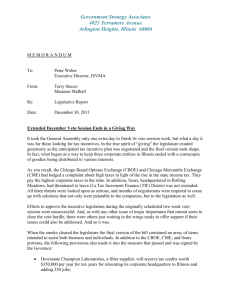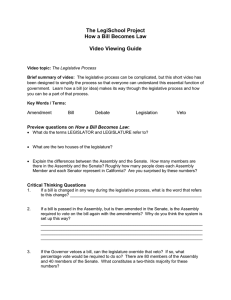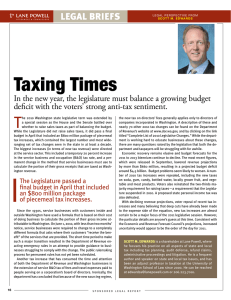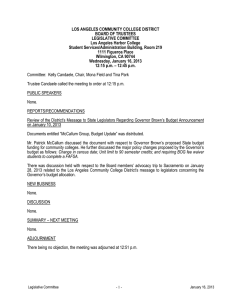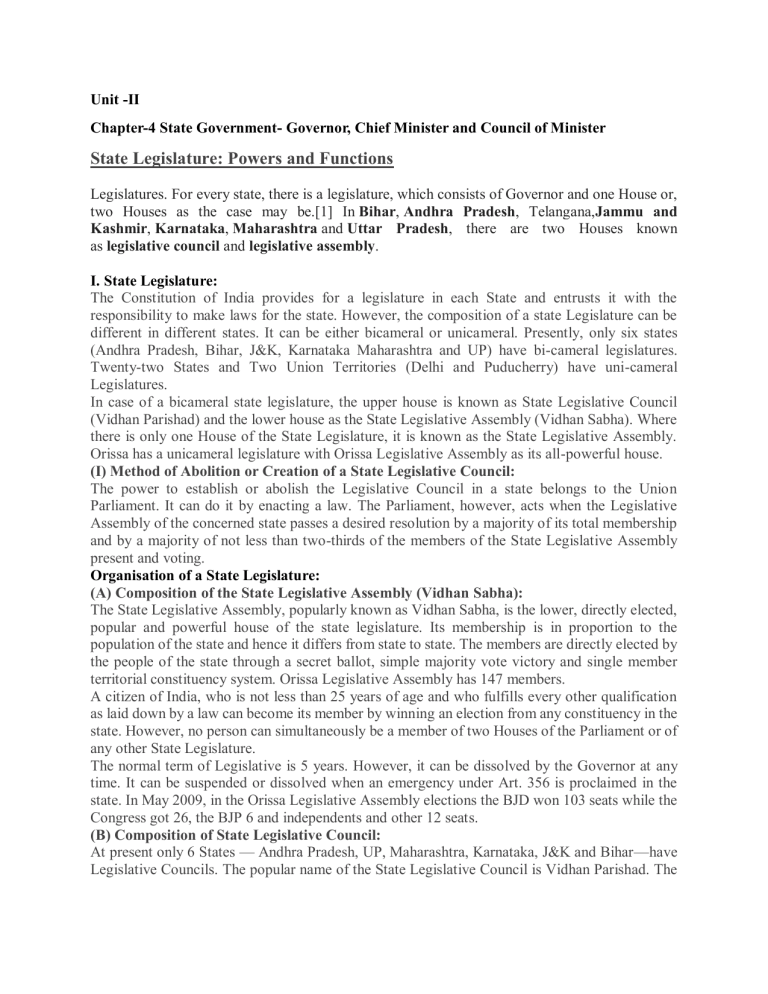
Unit -II Chapter-4 State Government- Governor, Chief Minister and Council of Minister State Legislature: Powers and Functions Legislatures. For every state, there is a legislature, which consists of Governor and one House or, two Houses as the case may be.[1] In Bihar, Andhra Pradesh, Telangana,Jammu and Kashmir, Karnataka, Maharashtra and Uttar Pradesh, there are two Houses known as legislative council and legislative assembly. I. State Legislature: The Constitution of India provides for a legislature in each State and entrusts it with the responsibility to make laws for the state. However, the composition of a state Legislature can be different in different states. It can be either bicameral or unicameral. Presently, only six states (Andhra Pradesh, Bihar, J&K, Karnataka Maharashtra and UP) have bi-cameral legislatures. Twenty-two States and Two Union Territories (Delhi and Puducherry) have uni-cameral Legislatures. In case of a bicameral state legislature, the upper house is known as State Legislative Council (Vidhan Parishad) and the lower house as the State Legislative Assembly (Vidhan Sabha). Where there is only one House of the State Legislature, it is known as the State Legislative Assembly. Orissa has a unicameral legislature with Orissa Legislative Assembly as its all-powerful house. (I) Method of Abolition or Creation of a State Legislative Council: The power to establish or abolish the Legislative Council in a state belongs to the Union Parliament. It can do it by enacting a law. The Parliament, however, acts when the Legislative Assembly of the concerned state passes a desired resolution by a majority of its total membership and by a majority of not less than two-thirds of the members of the State Legislative Assembly present and voting. Organisation of a State Legislature: (A) Composition of the State Legislative Assembly (Vidhan Sabha): The State Legislative Assembly, popularly known as Vidhan Sabha, is the lower, directly elected, popular and powerful house of the state legislature. Its membership is in proportion to the population of the state and hence it differs from state to state. The members are directly elected by the people of the state through a secret ballot, simple majority vote victory and single member territorial constituency system. Orissa Legislative Assembly has 147 members. A citizen of India, who is not less than 25 years of age and who fulfills every other qualification as laid down by a law can become its member by winning an election from any constituency in the state. However, no person can simultaneously be a member of two Houses of the Parliament or of any other State Legislature. The normal term of Legislative is 5 years. However, it can be dissolved by the Governor at any time. It can be suspended or dissolved when an emergency under Art. 356 is proclaimed in the state. In May 2009, in the Orissa Legislative Assembly elections the BJD won 103 seats while the Congress got 26, the BJP 6 and independents and other 12 seats. (B) Composition of State Legislative Council: At present only 6 States — Andhra Pradesh, UP, Maharashtra, Karnataka, J&K and Bihar—have Legislative Councils. The popular name of the State Legislative Council is Vidhan Parishad. The total membership of a Legislative council cannot be normally less than 40 and more than l/3rd of the total membership of the State Legislative Assembly. Andhra Pradesh Vidhan Parishad has 90 members UP Vidhan Parishad 100, Maharashtra Vidhan Parishad 78, J&K Vidhan Parishad 36, Bihar Vidhan Parishad 75 and Karnataka Vidhan Parishad 75 members. The membership of Vidhan Parishad includes elected as well as nominated representatives from several types of constituencies. The following formula is used: (i) 1/3rd members are elected by the members of State Legislative Assembly. (ii) 1/3rd members are elected by local bodies of the state. (iii) 1/12th members are elected by teachers of at least three years standing, serving educational institutions of the state. (iv) 1/12 members are elected by state university graduates of not less than three years-standing. (v) 1/6th members are nominated by the Governor of the state. Any citizen of India who is not less than 30 years of age, who possesses all the qualifications as laid down by the Parliament, who is not a member of any other legislature or Union Parliament can become a member of the State Legislative Council either by winning an election or by securing Governor’s nomination. Legislative council is a semi-permanent House. It is never dissolved as a whole. 1/3rd of its members retires after every 2 years. Each member has a term of 6 years. Powers and Functions of a State Legislature: Each State Legislature exercises law-making powers over the subjects of the State List and the Concurrent List. In case a state has a unicameral legislature, i.e., in case it has only State Legislative Assembly, all the powers are exercised by it. However, even in case it is a bicameral state legislature with state Legislative Council (Vidhan Parishad) as the upper house and state Legislative Assembly as the lower house, almost all the powers are exercised by the latter. The Legislative Council plays only a secondary and minor role. Powers of State Legislature: 1. Legislative Powers: The State Legislature can make laws on the subjects of the State List and the Concurrent List. It can enact any bill on any subject of State List, which becomes an Act with the signatures of the Governor. Normally, the Governor acts as a nominal and constitutional head and as such follows the advice of the state Chief minister and his Council of Ministers. However, he can reserve some bills passed by the State Legislature for the approval of the President of India. Further, in case a law made by the State Legislature on a concurrent subject comes into conflict with a Union Law on the same subject, the latter gets precedence over the former. In ordinary law-making, both the Houses (Legislative Assembly and Legislative Council wherever these exist together) have co-equal powers. In practice the Legislative Assembly dominates the law-making work. Most of the non-money ordinary bills are introduced in the Legislative Assembly and it plays a major role in their passing. The Legislative Council acts only as a revising and delaying second chamber. A bill passed by the Legislative Assembly and rejected by the Legislative Assembly or not decided upon by the latter within 3 months, when re-passed by the Legislative Assembly becomes an Act after the expiry of one month from the date on which it was sent to the Legislative Council a second time. A bill first passed by the Legislative Council becomes an Act only when it gets the approval of the Legislative Assembly. Thus, Legislative Council can only delay the passing of an ordinary bill by a maximum of 4 months. In case the State Legislature is a unicameral body, all the law-making powers are exercised by the Legislative Assembly. 2. Financial Powers: The State Legislature has the power to levy taxes in respect of all subjects of the State List. It is the custodian of the finances of the state. Mo revenue can be collected or tax can be levied or collected by the state government without the consent of the State Legislature. The budget and all other financial policies and programmes of the state government become operational only after getting an approval from the State Legislature. However, in emergencies declared under Articles 352, or 356 or 360, the financial powers of the state become subordinate to the Union. When the state is under a constitutional emergency (Art. 356), the State Legislature stands either suspended or dissolved. In this situation, the financial powers for the state are exercised by the Union Parliament. When a State Legislature is unicameral, all the financial powers are naturally exercised by the Legislative Assembly. However, even when it is bi-cameral, the real financial powers are in the hands of the Legislative Assembly. A money bill can be introduced only in the Legislative Assembly and after passage it goes to the Legislative Council. The latter can delay its passage for only 14 days. In case, it rejects or amends the bill, the decision of the Legislative Assembly prevails. When the Legislative Council returns a financial bill to the Legislative Assembly with some amendments, it is the power of the Legislative Assembly to accept or reject these. Thus, in respect of financial powers, the real authority is in the hands of the State Legislative Assembly. 3. Power to control the Executive: Control over the State Council of Ministers is exercised by the State Legislative Assembly. Little role has been assigned to the State Legislative Council. The state Chief minister is the leader of majority in the State Legislative Assembly. The State Council of Ministers is collectively responsible before the Legislative Assembly. The latter can cause the fall of the ministry by passing a vote of no-confidence or by rejecting a bill or policy or budget sponsored by the Council of Ministers. The State Legislative Council can exercise only a limited control over the ministry by putting questions and supplementary questions to the ministers. 4. Other Powers: The State Legislature, particularly its Legislative Assembly, exercises several other powers. The elected members of the Legislative Assembly (MLAs) participate in the election of the President of India. They also elect representatives of the state in the Rajya Sabha. Certain constitutional amendments can be made by the Union Parliament only with the ratification by at least half of the State Legislatures. The state legislature considers the reports of the State Public Service Commission, State Auditor General, and others. It also acts as a forum for ventilation of the grievances of the people. The State Legislative Assembly has the right of adopting a resolution for the creation or abolition of the State Legislative Council. Position of a State Legislature: The State Legislature occupies the same position in a state as is the position of the Parliament in the Union. There is, however, a difference of degree in their relative powers. Indian Unitarian Federalism makes the Union Parliament more powerful than each state legislature. Further, there are several specific limitations on the powers of a state legislature. Some Limitations on the Powers of State Legislature: (1) Prior consent of the President of India for introduction of some Bills: There are certain bills which can be introduced in a state legislature only with the prior consent of the President of. India. (2) Reservation of bills by the Governor for President’s Assent: There are certain bills, which after having been passed by the state legislature, can be reserved by the Governor for the consent of the President. Such bills become laws only after the President has given his assent. (3) Limitation that can be imposed by the Rajya Sabha: The Union Parliament gets the power to pass laws on the State List, (for one year) if the Rajya Sabha adopts a resolution (supported by 2/3rd majority of the members present and voting) and declares a state subject mentioned in the resolution as a subject of national importance. (4) Limitations during national Emergency: When a national emergency (Under Art. 352) is in operation, the Parliament is empowered to pass a law on any subject of the State List. The law so passed operates during the period of emergency and for six months after the end of the emergency. (5) Limitations during a Constitutional Emergency: During the operation of constitutional emergency in a state under Art 356, the Union Parliament gets the authority of making laws for that state. The State Legislature stands either dissolved or suspended. (6) Discretionary Powers of the Governor: Discretionary powers of the Governor of a state also constitute a limitation on the State Legislature. Whenever he acts in his discretion, he is beyond the jurisdiction of the State Legislature. Acting in his discretion, the Governor can even dissolve the State Legislative Assembly. (7) Precedence of Union Laws on the Concurrent Subject: They State Legislature and the Union Parliament, both have the concurrent power to make laws on the subjects of the Concurrent List. If both the Union Parliament and a State Legislature pass a law on the same subject of the Concurrent List and there is inconsistency between the two, the law passed by the Union Parliament gets precedence over the corresponding state law. Thus, each state legislature in India exercises law-making powers over the subjects given to it by the Constitution. However, even in respect of these, it exercises law-making powers under the above constitutional limitations. Nevertheless, in general the State Legislatures act as important and powerful legislatures in all the 28 States and 2 Union Territories of India. Powers and Functions of Governor of an Indian State Under the Constitution of India, the machinery of the State Government is the same as that of the Central Government. Like the Union Government, the State Governments are also formed on the parliamentary pattern. The Governor is the chief executive of a State in India. The powers and functions of the Governor of Indian State resembles that of the President of the Union Government. Like the President, the Governor is also a constitutional ruler, a nominal figure. He is not a real functionary. Generally speaking, the Governor acts on the advice of the Council of Ministers. The Governor is appointed by the President of India. He holds office during the pleasure of the President. Under the Constitution of India, the Governor of a State possesses wide powers and functions – executive, legislative, financial and judicial. Let us now discuss the powers and functions of the Governor of an Indian State. 1. Executive: The Executive power of the State is vested in the Governor. He exercises this power either directly or through the officers who are subordinate to him. All executive actions of the State are taken in the name of the Governor. An important function of the Governor is to appoint the Chief Minister of the State. Other ministers are also appointed by the Governor on the advice of the Chief Minister. The ministers including the Chief Minister hold office during the pleasure of the Governor. He has also the power to appoint the higher officers of the State including the Advocate-General and the members of the State Public Service Commission. He has also a share in the appointment of the Judges of High Court. He is responsible for the administration of the welfare schemes of the scheduled castes and other backward class. He may appoint a minister for this purpose. The Governor has the constitutional right to know the decisions of the Council of Ministers relating to the administrative affairs of the State and the proposals for legislation. But like the President of the Union, the Governor has no diplomatic or military power. 2. Legislative: Governor is an integral and indispensable part of the State Legislature. In some States, the State Legislature consists of the Governor and one House, the Legislative Assembly, while in other it consists of the Governor and the two Chambers known as the Legislative Assembly and the Legislative Council. The Governor possesses the powers to summon and prorogue the Houses of the State Legislature. He can also dissolve the Lower House—the Legislative Assembly—before the expiry of its term. The Governor has been authorized by the Constitution to deliver an address to the State Legislature at the commencement of the first session of each year. He has also the power to send message to the State Legislature. The Governor has to nominate one member to Legislature. The Governor has to nominate one member to Legislature Assembly from the Anglo-Indian Community and also members to the Legislative Council (where it exists) from among the persons who have acquired special knowledge in art, literature, science, social service and co-operative movement. In a State, a public bill cannot become an Act without the approval of the Governor. A bill passed by the State Legislature is presented to the Governor for his assent. The Governor may give his assent to the bill. Or he may withhold his assent from the bill. If the bill is again passed by the House or Houses of the State Legislature, the Governor is to give assent to the bill. He may also reserve certain bill for the assent of the President. This is an important function of the Governor of an Indian State. When the State Legislature is not in session, the Governor may issue an Ordinance. It has same force as the law of the State Legislature. But it must be placed before the Legislature when it assembles again. If it is approved by the State Legislature, it will cease to operate after six weeks of the date of meeting of the State Legislature. 3. Financial: The Governor has also financial powers and functions. No money-bill can be originated in the State Legislature without the recommendation of the Governor. In every year, the budget is laid before the State Legislature by the Governor. No proposals for taxation or expenditure can be made without the approval of the Governor. 4. Judicial: The Governor also exercises judicial powers. He has the power to grant pardons, reprieves or remissions of punishment to any person who has been convicted by courts of law. He has also a great share in the appointment of the judges of the subordinate courts. Besides, the Governor of a State also enjoys discretionary powers. As for example, the Governor of Assam can exercise the administration of the tribal areas independently of his ministry. Again, the Governor of a State when he is appointed as the administrator of an adjoining Union Territory may exercise his function without the advice of the Council of Ministers. It is true that Governor is constitutional ruler and a nominal figure. But he is not a magnificent cipher or a rubber stamp. The Governor enjoys wide powers in executive, legislative and financial spheres. He can exercise certain powers in his own discretion. The Governor has the power to advise to encourage and to warn the ministry irrespective of their party colors. The office of the Governor depends upon the personality and ability of the person who occupies it. If the Governor is a man of strong personality, he can easily influence his ministry. A weak and lazy Governor, on the other hand; will be influenced by the ministry. He will them exercise the functions according to the directions issued by the Council of Ministers. Powers and Functions of Chief Ministers The powers and functions of the Chief Minister can be discussed under the following heads: 1. The Leader of the Legislative Assembly: The Chief Minister is the leader of the Legislative Assembly of the State. On his advice the Governor exercises his functions in matters like summoning, proroguing or, if necessary, dissolving the Legislative Assembly. As the chief spokesman of the State Government, he explains the government policies. In the matter of determining the internal policies of the State, the decision of the Chief Minister is final. He comes to the rescue of a minister if he faces any difficulty during the debates in the Assembly. He has to bear the responsibility of getting the important Bills passed. He remains responsible to the Legislative Assembly for the acts performed by the State Council of Ministers. He has to take great care to ensure smooth conduct of the proceedings of the State Legislature by maintaining contacts and good relations with the opposition. In case of conflict arising between him or the Council of Ministers led by him and the State Legislature, he can advise the Governor to dissolve the Legislative Assembly. In such cases, the Governor may also reject his advice by exercising his ‘discretionary powers’. 2. The Leader of the Council of Ministers: The Constitution virtually gives a preeminence to the leadership of the Chief Minister by placing him ‘at the head’ of the Council of Ministers. The Governor appoints or dismisses other ministers on his advice. The Chief Minister allocates or re-allocates the portfolios among the ministers. The responsibility for maintaining unity and integrity among the members of the Council of Ministers lies mainly with him. The policies and workings of the different ministries are monitored and coordinate by him. He summons and presides over the meetings of the Council of Ministers. If there is any conflict of opinion between the Chief Minister and any other minister, the latter has to resign. If the Chief Minister resigns, the entire Council of Ministers is bound to resign. So, in case of necessity, he tries to keep the Council of Ministers under his control by brandishing the threat of resignation’. In view of his total control over the Council of Ministers, he is described by many as ‘the corner-stone of the Cabinet arch’ in the state. 3. The chief adviser to the Governor: The Chief Minister is the chief adviser to the Governor. Generally the Governor exercises all his functions on the advice of the Chief Minister. Besides, he has to act as the principal channel of communication between the Governor and the Council of Ministers. It is his duty to communicate to the Governor all decisions of the Council of Ministers. He has to furnish such information relating to the affairs of the State as the Governor may call for. 4. The Leader of the majority party or alliance: It is the leader of the majority party or alliance in the Legislative Assembly whom the Governor appoints the Chief Minister. He has to lead the party in and outside the Assembly, and to see that the image, popularity, integrity and discipline of the party are maintained. He is always active to reconcile the policy of the party or the alliance with that of the Government.The popularity of the ruling party largely depends on the personality and efficiency of the Chief Minister. 5. Miscellaneous functions: It is an important function of the Chief Minister to maintain contact with the people at large. He has to keep a watchful eye on the public opinion at the time of formulating government policy and performing his functions. He discusses the problems and issues of the State and tries to form public opinion in support of his party or alliance through his speeches in the radio, the T.V., public meetings etc. The State Council of Ministers: it’s Power and Functions The Constitution provides that there shall be a Council of Ministers with the Chief Minister at the head to aid and advice the Governor in the exercise of his functions except in so far as he is by or under the Constitution required to act in his discretion.he Constitution provides that there shall be a Council of Ministers with the Chief Minister at the head to aid and advice the Governor in the exercise of his functions except in so far as he is by or under the Constitution required to act in his discretion. The governor appoints the Chief Minister and other Ministers on the advice of the Chief Minister. The Council of Ministers constitutes the real executive in the State. Although the administration is carried on in the name of the Governor, actual decisions are normally made by Ministers. Under ordinary circumstances, the Governor has to follow their advices. It is the duty of the Chief Minister of a State to communicate to the Governor regarding administration and the affairs of the State. Thus, in theory the Governor may dismiss a minister if he so likes, but in view of the collective responsibility of the Council of Ministers to the State Legislative Assembly, he is not likely to use this power in actual practice. The governor appoints the Chief Minister and other Ministers on the advice of the Chief Minister. The Constitution defines the position of the Council of Ministers in relation to the State Legislature by providing that the Council of Ministers is collectively responsible to the Legislative Assembly of the State. This means that they can remain in office only if they enjoy the support of a majority of members of the State Legislative Assembly. The number of the ministers is not fixed. It is for the Chief Minister to determine the size of the Council of Ministers and he does so as the requirements of the occasion may demand.; The only constitutional requirement is that in the States of Bihar, Madhya Pradesh, and Orissa the Council of Ministers must have a Minister in charge of Tribal welfare and the same Minister may also be entrusted with the welfare of the Scheduled Castes and Backward Classes in the State. Powers and Functions of the Council of Ministers: The Council of Ministers performs the following functions: (i) Formulation of Policies: The Ministers formulate the policies of the government. The Cabinet takes decisions on all major problems—public health, relief to the disabled and unemployed, prevention of plant diseases, water storage, land tenures and production, supply and distribution of goods. When it has formulated a policy, the appropriate department carries it out. (ii) Administration and Maintenance of Public Order: The executive power is to be exercised in such a way as to ensure compliance with State laws. The Constitution empowers the Governor to make -rules for the more convenient transaction of the business of the Government. All such rules are made on the advice of the Council of Ministers. (iii) Appointments: The Governor has the power to appoint the Advocate-General and the Members of the State Public Service Commission. The Vice-Chancellors of the State Universities and members of various Boards and Commissions are all appointed by the Governor. The Governor cannot make these appointments at his will. He must exercise these functions on the advice of his ministers. (iv) Guiding the Legislature: Most of the Bills passed by the Legislature are Government Bills, prepared in the ministries. They are introduced, explained and defended in the State Legislature by the Ministers. The Cabinet prepares the Governor’s Address in which it sets forth its legislative programme at the commencement of the first session of the Legislature each year. For weeks at a stretch the Cabinet’s proposals take over every working moment of the House. The Cabinet makes sure that all government bills will be translated into laws. (v) Control over the State Exchequer: The State budget containing the estimates of income and expenditure for the ensuing year is placed by the Finance Minister before the State Legislature. The Legislature cannot take the initiative in the case of a Money Bill. Such a Bill must be recommended by the Governor and can be introduced only by a Minister. The initiative in financial matters lies with the Executive. (vi) Execution of Central Laws and Decisions of the Union Government: The Union Government is empowered to give directions to the State-governments in certain matters. The States should exercise their executive power so as to ensure compliance with the laws made by Parliament. They should not do anything which would hamper the executive power of the Union. Railways, for instance, is a Union subject, but police, including railway police, is a State Subject. The Union Government can give directions to the State Executive as to the measures to be taken for the protection of railways within the State.

